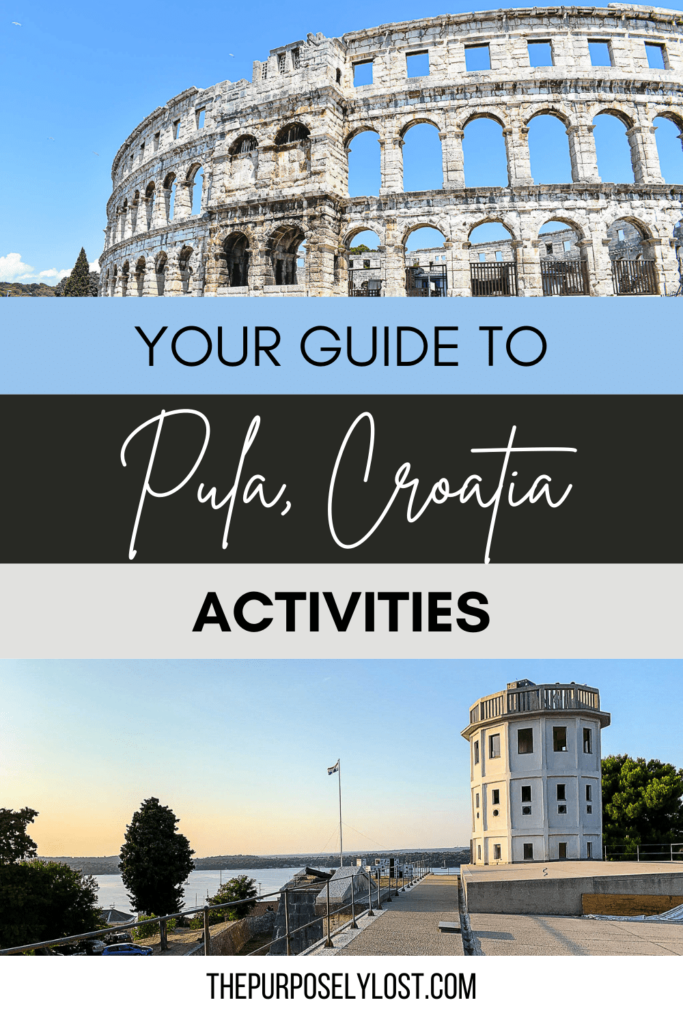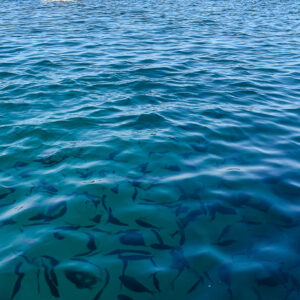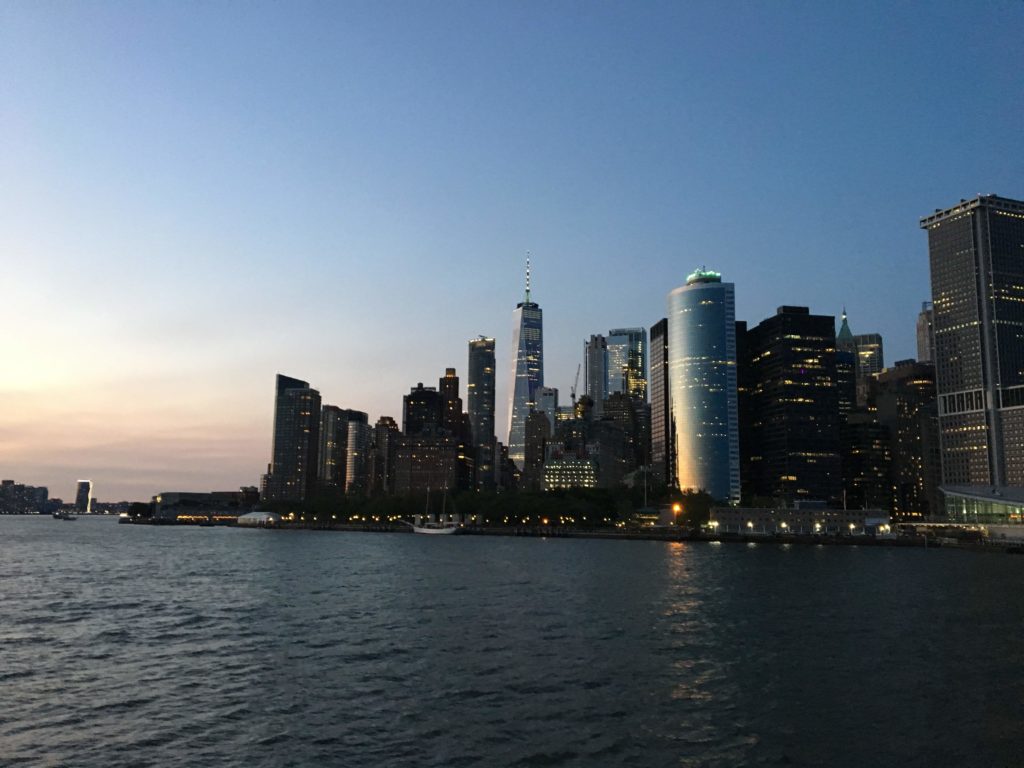Contents
- 1 What to do in Pula Croatia
- 1.1 1. Visit the Pula Arena
- 1.2 2. Walk around Pula Old Town
- 1.3 3. Explore Forum Square and see the Temple of Augustus
- 1.4 4. Take a walking tour of Pula
- 1.5 5. Walk around Tito’s Park by the harbor
- 1.6 6. Visit the Pula Cathedral
- 1.7 7. See the Arch of the Sergii
- 1.8 8. Sit by the James Joyce Statue
- 1.9 9. Walk around the Church and Monastery of St. Francis
- 1.10 10. Climb to the top of the Kaštel
- 1.11 11. Walk through the Gate of Hercules
- 1.12 12. See the remaining chapel of the Basilica of Santa Maria del Canneto
- 1.13 13. Check out the Kažnjavanje Dirke Mosaic
- 1.14 14. Visit the Pula Aquarium
- 1.15 15. Take a boat tour through Brijuni Islands National Park
- 1.16 16. Relax on one of Pula’s beaches
- 1.17 17. Stroll through the Twin Gates to reach the Archaeological Museum of Istria
- 1.18 18. Learn to taste at the Museum of Olive Oil
- 1.19 19. Visit one of Pula’s other incredible museums
- 1.20 20. Go underground at Zerostrasse
- 1.21 21. Visit the remains of Agrippina’s House
- 1.22 22. Grab a bite at the Gradska Tržnica
- 1.23 23. See The Lighting Giants
- 1.24 24. Attend the Vinski Grad this summer
- 1.25 25. Watch for dolphins in the water while enjoying the sunset
- 1.26 26. Take a guided tour to Istrian cities near Pula
- 1.27 27. Visit Cape Kanenjak on the Premantura peninsula
- 1.28 28. Explore outside the city center on a Pula Highlights Bike Adventure
- 1.29 29. Go on a Pula kayaking adventure
- 1.30 30. Take a day trip to another Istrian, or Italian, city
- 2 What to do in Pula Croatia: FAQs
- 3 Pula Croatia Things to do: Wrap-Up
This post may contain affiliate links! I will receive a commission, at no extra cost to you, if you purchase something recommended here.
The largest city in the Istria region and the eighth-largest in Croatia, Pula is an incredible city that history buffs will be absolutely fascinated by.
Artifacts from the earliest humans in ancient history have been found on the hills around this charming city, dating back over one million years.
In marginally more modern times, Pula has been conquered and ruled over by the Romans, the Ostrogoths, the Byzantines, and the Venetians.
And in the last 250 years, the French, the Austro-Hungarians, and the Italians, before becoming part of Yugoslavia–and now, Croatia.
I spent some time exploring this port city when I lived in Croatia with a local family, and I can’t wait to go back! Beautiful beaches, natural park areas, and incredible ancient architecture surround you, all making my list of the best things to do in Pula.
What to do in Pula Croatia
1. Visit the Pula Arena

Built within the 1st-century C.E. during the reign of Roman Emperor Augustus, the Pula Arena is an incredible example of Ancient Roman architecture.
One of the largest surviving Roman amphitheaters left, it’s the only one with all four sides of its top intact.
It could accommodate about 23,000 spectators at once and hosted festivals, gladiator fights, and a host of other events throughout its history.

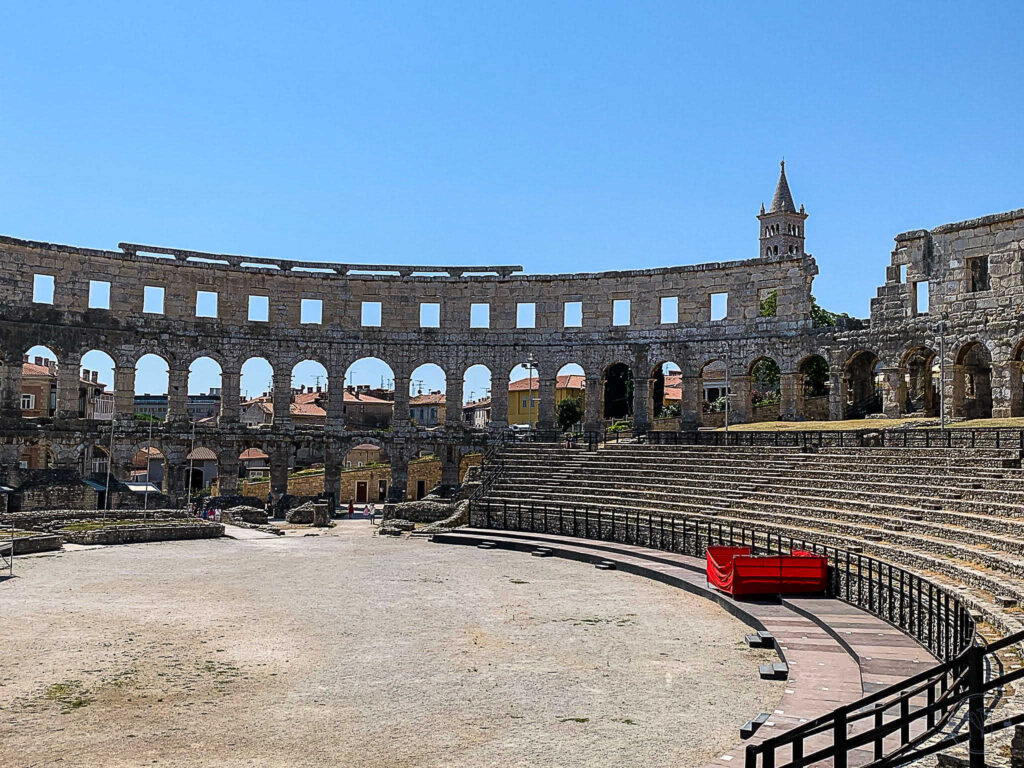
Interestingly enough, even though the Pula Area is very well preserved and included on Croatia’s own national landmarks list, it’s not considered a UNESCO World Heritage Site.
The decision to grant it UNESCO status was “postponed” in 2000.


However, the UNESCO List loss is really our gain!
The Pula Arena has been used for outdoor film festivals, concerts, and every summer–gladiator fights.
Spectacvla Antiqva is an incredible production performed in English and explains the history and chronology of the different levels of fighting and gladiators as it happens.
It was SO COOL–definitely one of my favorite Pula activities!
Once you’ve finished walking around the different areas outside, make sure you head underground to see the small museum located underneath the Arena.
Grab your Pula Arena entrance ticket here!
2. Walk around Pula Old Town

When you look at Pula on a map, the distance to walk around the city center is a little misleading.
The streets are laid out in circles that stem from the fortress.
But, the fortress is at the top of a hill, and the city spirals down from around the top.
Today, when you’re walking down the street, you might notice that every street sign is listed in both Croatian and Italian.
The Austrian-Hungarian Empire took charge of the region from 1797 to 1918 (with a small break during the Napoleonic years,) but in the intervening years through World War II–until the area joined Yugoslavia–it was controlled by Italy.
This means Istria has two “national” languages, Croatian and Italian.
3. Explore Forum Square and see the Temple of Augustus

Where Ancient and Medieval architecture meets. Forum Square–also known as Trg Forum or Piazza Foro–has been the center of the city’s political and social spheres since ancient times.
Initially, there were three temples here, but unfortunately, only the Temple of Augustus still stands.
Since its origin as a temple in ancient times, it’s been used as a Christian church, a storehouse for grains, and then as a museum for stone monuments.
It was totally destroyed during a World War II bomb raid but restored to its original glory by 1947.
You can go inside the Temple of Augustus, but there’s honestly not much to see inside, and it costs a few kuna for an entrance fee.

Next to the Temple of Augustus, you’ll find the City Hall Building (Zgrada gradske vijećnice.)
If you’re thinking that it was built in a different era than its neighbor, you’d be right.
Completed in 1296 in the Gothic style, the building was added to several times over the centuries to include elements of the Renaissance and Baroque styles.
Fun Fact: The Temple of Diana, one of the original three temples that stood in the Square, was incorporated into the building; if you head to the back, you’ll be able to see it.
4. Take a walking tour of Pula

As you might know, if you’ve been here before, I was (and still am) a licensed New York City tour guide. So you could say, taking tours is my thing!
When I was visiting Pula attractions, I took a phenomenal free walking tour by Fat Cat Walks.
Since it’s a one-man operation, you have to check the Facebook page to find out when Saša is offering tours, but if your schedule lines up–G.O.!
If you’re visiting the coastal town and Fat Cat Walks isn’t offering a tour within your schedule, take a look at this other guided walking tour around Pula.
Pro Tip: Remember to tip your tour guides! Especially when you take a free walking tour, your tip is how the tour guide gets paid. And positive reviews on places like TripAdvisor or GetYourGuide go a long way!
5. Walk around Tito’s Park by the harbor

Pula has several parks that run along the water where you can spend some time wandering around.
Tito’s Park is where you can find a memorial to deceased soldiers and ten bust monuments dedicated to Croatian heroes.
And make sure to check out the scale model of the city depicted in bronze!
6. Visit the Pula Cathedral

The earliest pieces of the Pula Cathedral (Katedrala Uznesenja Blažene Djevice Marije / Cattedrale di Pola), fully known as the Cathedral of the Assumption of the Blessed Virgin Mary, were built from the late 4th century through the early 5th century C.E.
If you walk to the back of the church, you can actually see part of an original wall!
Although the church had initially been adorned with beautiful floor mosaics and frescos inside, it has been reconstructed several times over the centuries; now, only a tiny piece of a floor mosaic is still visible.
The Cathedral still offers mass at least once every day; you can check the schedule on their website.
7. See the Arch of the Sergii

Standing on what was once the outskirts of the city, the Triumphal Arch of the Sergii (Sergius) was originally a city gate to get into Pula.
It was paid for by the wife of Lucius Sergius Lepidus to honor his victory in Battle at Actium and is thought to have been built between 29–27 B.C.E.
8. Sit by the James Joyce Statue

Right next to the Arch of Sergii, you might recognize the man commemorated in bronze.
There’s a statue of James Joyce sitting on a ledge, overlooking the arch and the walkway below.
The famous Irish writer lived in Pula for about six months in 1904-05, teaching English to Austro-Hungarian naval officers at the Berlitz School.
Even though he famously didn’t enjoy his time here–calling the city “a naval Siberia”–the city decided to immortalize him as a bronze statue looking towards the Arch of Sergii.
Read More
- Your Guide to 3 Days in Split, Croatia
- Your Guide to the Best Things to do in Split, Croatia
- The Best Day Trips from Split, Croatia
- Stunning Instagrammable Places and Photo Spots in Split, Croatia
- The Best Beaches in Split, Croatia
- Your Guide to the Best Nightlife in Split, Croatia
9. Walk around the Church and Monastery of St. Francis

Once Pope Innocent III approved the Franciscan order, an outpost was established in Pula.
The Church and Monastery of St. Francis was built around the turn of the 13th century with a simple rectangular floor plan.
Inside, the beautiful golden altar dates back to the 15th century, and you can find a Roman mosaic on the floor of an interior chamber.
Fun Fact: Relics of the Franciscan priest Blessed Oton are on display inside. He was credited with performing several healings but never received beautification recognition from the Catholic Church.
10. Climb to the top of the Kaštel

Standing at the top of the hill in Pula, the Kaštel (Pula Castle) was designed by a French military architect named Antoine de Ville for the Venetians in the 1630s as a way to defend the coastal city and its vital harbor.
Now, the Historical and Maritime Museum of Istria (Povijesni i pomorski muzej Istre / Museo storico e navale dell’Istria) is housed inside.


Once you finish walking through the museum, walk around the top of the fortress for fantastic views of the Pula Arena and the rest of the city.
This is one of my favorite places to catch the sunset over Pula!
11. Walk through the Gate of Hercules

If you look closely at the top of the arch, you’ll see why it’s called the Gate of Hercules.
Up in the center, you can find the Ancient Greek demigod there with his infamous club.
Along with the carving, you’ll find the name of two Roman officials inscribed on the gate.
Lucius Calpurnius Piso and Gaius Cassius Longinus established the original colony in the 40s B.C.E.
If you walk through the Gate of Hercules–flanked by two simply designed Medieval-era towers–and head up the stairs, you’ll come to Circolo, a nice restaurant with a great rooftop terrace.
12. See the remaining chapel of the Basilica of Santa Maria del Canneto

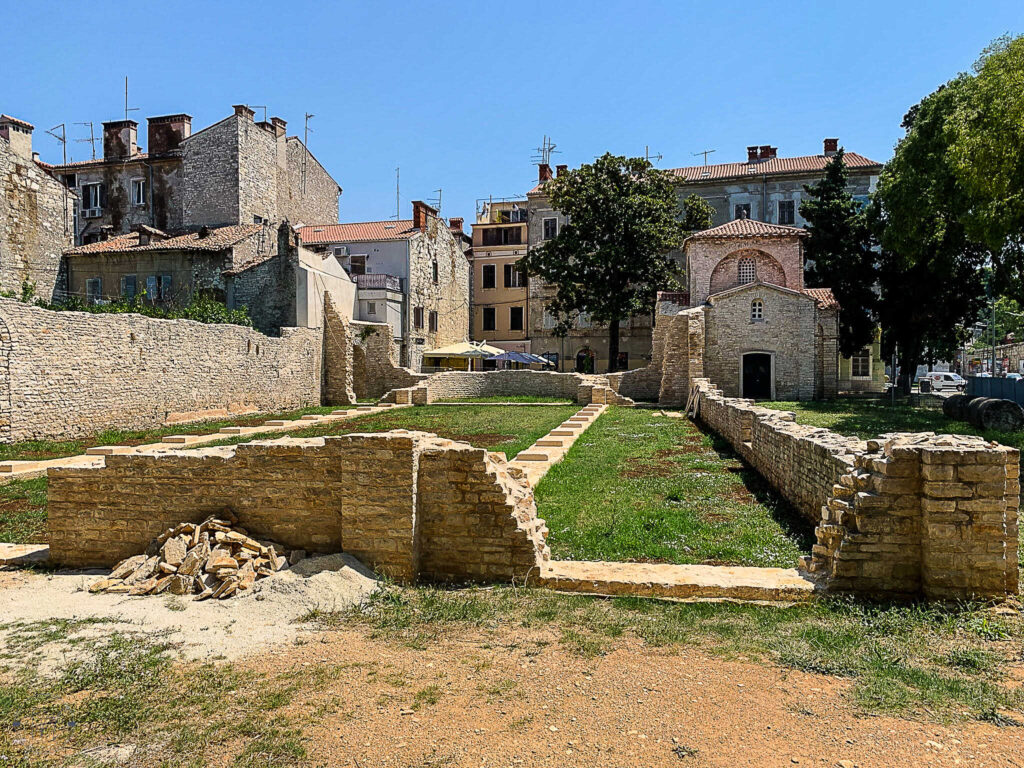
The Basilica of Santa Maria del Canneto, also known as Santa Maria Formosa (Crkva sv. Marija Formoza), was a Byzantine-style church built in the 6th century.
When the Venetians ransacked the city in 1243, they destroyed everything except for one of the church’s three chapels.
You can still see the outline of where the magnificent church once stood, along with the remaining chapel.
Fun Fact: Some of the original Basilica’s stones were transported to Venice, Italy and used to build the Biblioteca Nazionale Marciana and Basilica di San Marco. The four alabaster columns above the high alter in San Marco’s are thought to have been taken from Santa Maria del Canneto, too.
13. Check out the Kažnjavanje Dirke Mosaic

You can see a beautifully preserved ancient Roman floor mosaic if you know where to look.
Near the Chapel of Santa Maria Formosa, the estimated 3rd-century mosaic depicts a scene from The Punishment of Dirce myth.
It’s a free landmark in Pula to visit!
14. Visit the Pula Aquarium

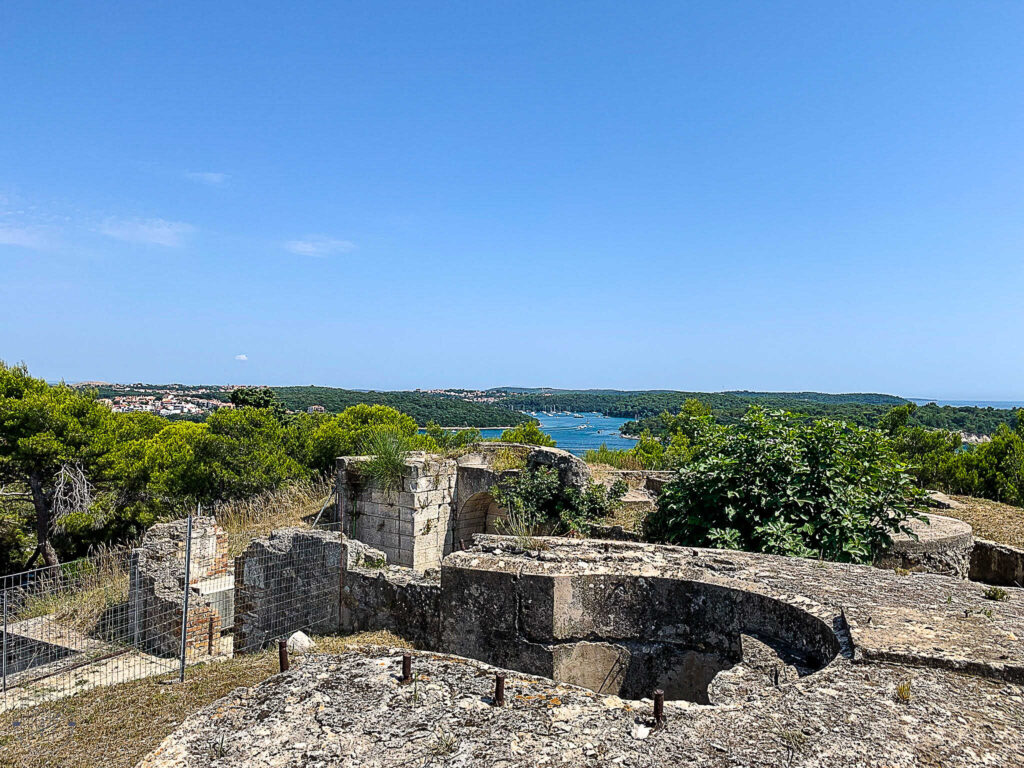
Housed in one of the 130-year-old Austro-Hungarian fortresses that made up the city’s defense complex, the Pula Aquarium is an excellent activity in Pula for kids and adults!
It’s the largest and most visited public aquarium in the country, beating Aquarium Terrarium, one of the best things to do in Šibenik, and others for the title.
You’ll find more than 200 species of fish and marine life here, as well as a turtle rescue center.
I spent a few hours roaming the tanks and exploring the different fish on display before taking the stairs to walk on top of the old Fort Verudela.
You’ll get panoramic views of the sea and the city from up top. Then walk over to Histria Beach or Ambrela Beach to relax in the sun.
15. Take a boat tour through Brijuni Islands National Park


Like its more famous cousin Kornati National Park and Archipelago, Brijuni National Park is also an island archipelago off the coast of Pula.
Largely uninhabited throughout history and most famous for their stone quarries, the islands were transformed into a popular holiday destination at the turn of the 20th century.


Following World War II, Yugoslavia’s President Marshal Josip Broz Tito used the islands as his summer residence.
When Croatia gained its independence in the 1990s, the archipelago was deemed a national park and international conference center.
If you decide to explore Brijuni National Park on your own, you need to visit Veliki Brijun Island.
Here you’ll find the Safari Park, a Dinosaur Park, the Brijuni Golf Course, Muzej Josipa broza Tita, and a few hotels where you can stay overnight.
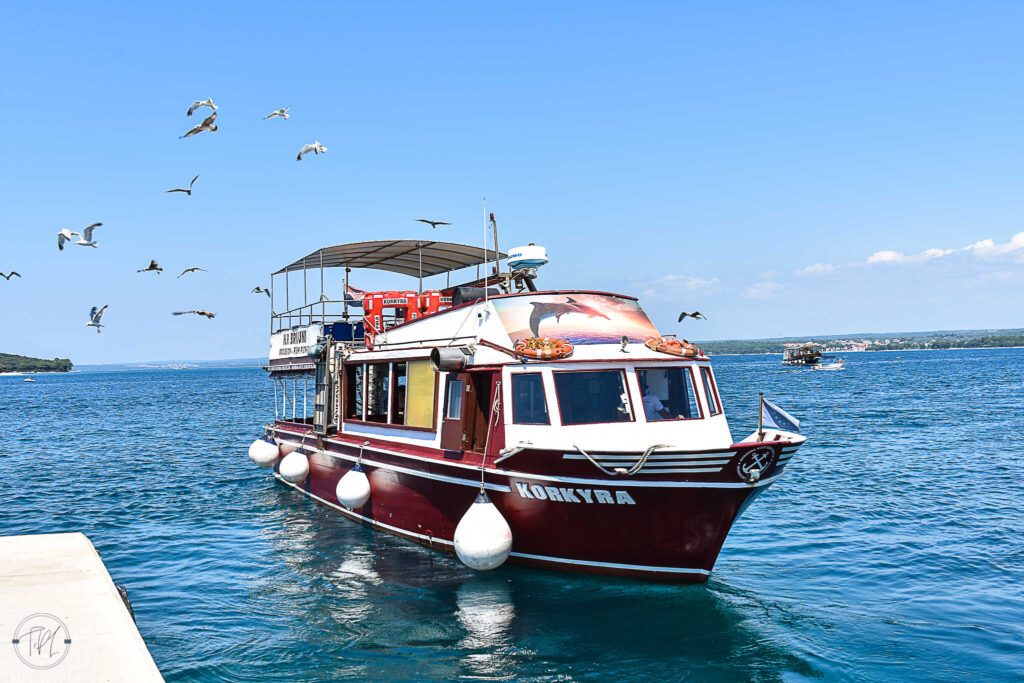

Although you can rent a boat and visit the national park yourself, I highly recommend this guided tour I took when I last visited Pula.
It left right from Pula’s harbor and stopped at several of the islands around the national park (but not Veliki Brijun Island.)
The tour also included lunch and a guide who pointed out the different islands and landmarks as we passed them by.
And yes, there are gorgeous peacocks strutting right up to you on the beaches!
16. Relax on one of Pula’s beaches
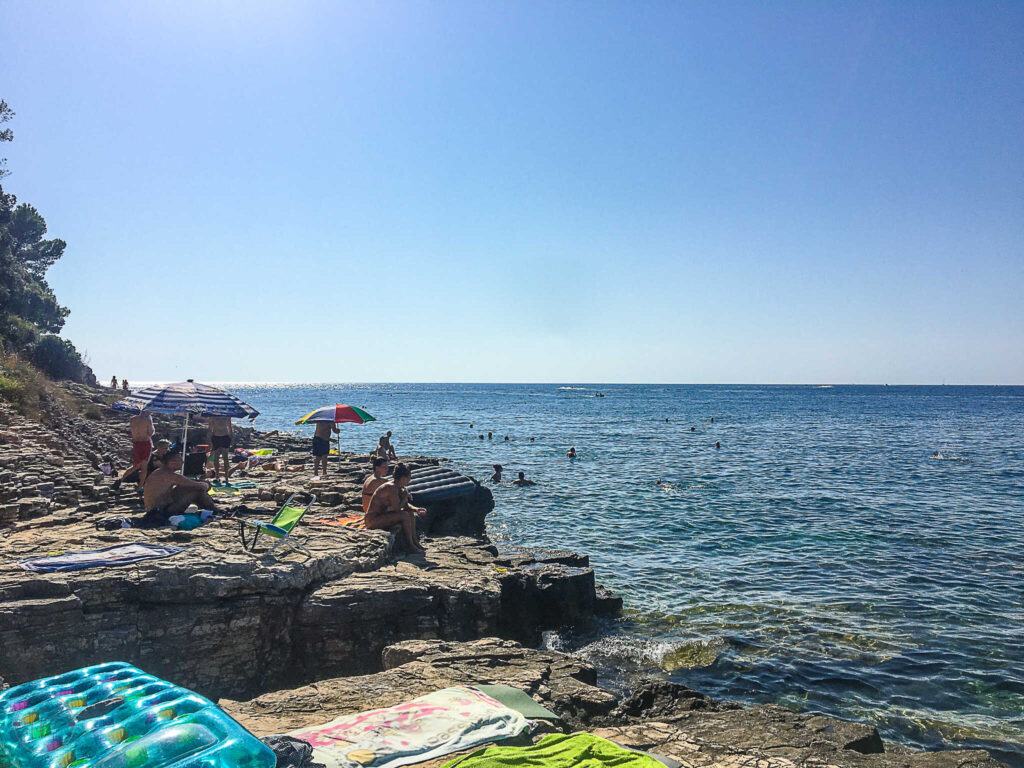
One of the most famous characteristics of any Croatia beach is its blue waters–and the lovely beaches in Pula are no exception!
I have a whole guide to the best beaches in Pula if you want to learn more, and my favorite Pula beaches include:
- Ambrela Beach
- Histria Beach
- Cyclone Beach
- Saccorgiana Cove
Insider Tip: If you’re visiting in the summer, you need to check out Zeppelin Beach Bar! Located next to Saccorgiana Cove, the bar is a favorite for locals and tourists in the summer. It has a great restaurant on-site, and you can rent cabanas, boats, jet-skis, and other water sports during the day–and party at the lounge bar at night.
Read More
- Split Old Town: Everything You’ll Ever Want To Know
- The Best Beaches in Šibenik, Croatia
- Your Guide for One Day in Trogir, Croatia
- Your Guide to 2 Days in Salzburg, Austria
- The Cost of Living In Rome, Italy: A Local’s Breakdown
- 20+ Things I Wish I’d Known Before Moving To Rome, Italy
17. Stroll through the Twin Gates to reach the Archaeological Museum of Istria


The Twin Gate was another entry point into the city of Pula.
Built in the 2nd century, the walls on either side of the gate were knocked down in the early 19th century to accommodate the expanding city.
Once you walk through the Twin Gate, you’ll find yourself standing in front of the Archaeological Museum of Istria (Arheološki muzej Istre.)
Here, you can see artifacts and relics from the many different ancient societies that lived in the region, all throughout various points in history.
The Archaeological Museum is also excavating and restoring the Small Roman Theater found on the museum’s grounds.
18. Learn to taste at the Museum of Olive Oil

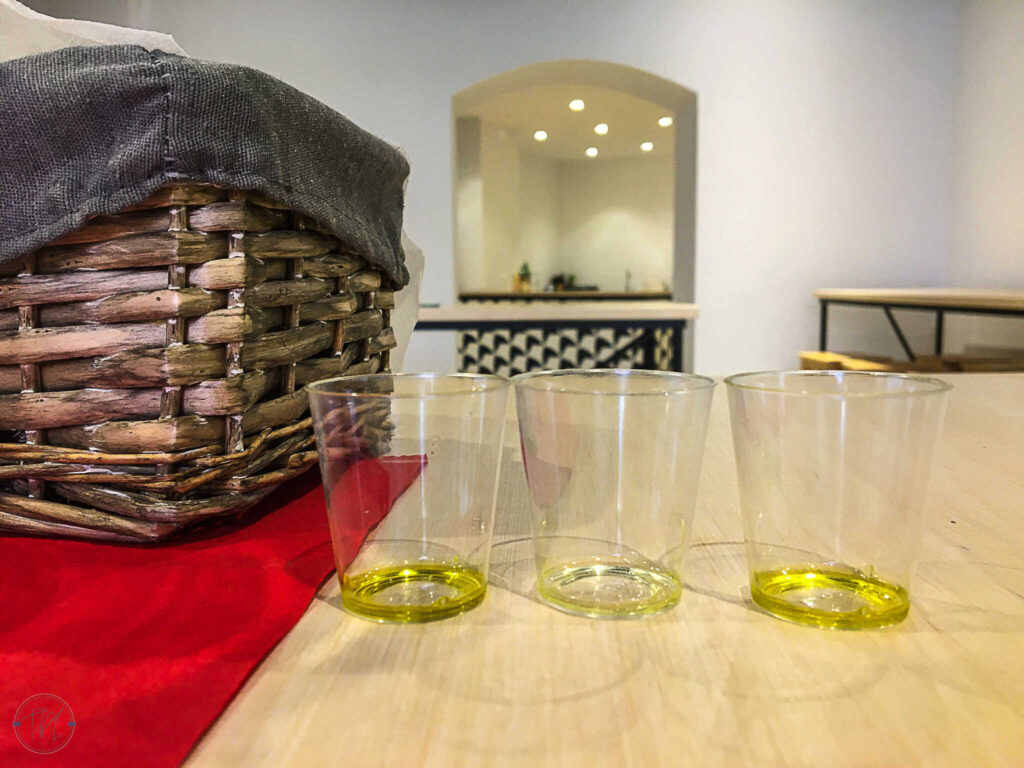
The region of Istria is affectionately referred to as Croatia’s “Tuscany.”
Along with the beautiful sweeping hillsides you’d find in its Italian neighbor, you’ll also find an exceptional tradition of wine, olive oil, and other foods.
Although Pula has several fascinating museums, the Museum of Olive Oil (Museum Olei Histriae) was my favorite!
They have rooms of exhibits showcasing the history and artistry behind olive oil production in the Istria region and information on how the practices have been adapted for modern times.
There are two different entry options. You can purchase a ticket to only explore the museum; or, you do want I did and include an olive oil tasting in your price of admission.
This was one of my favorite things to do in Pula!
After I finished exploring the museum, we went into their tasting room for a presentation on different types of olive oil, what is actually “extra virgin,” and how to differentiate the tastes between true versus fake extra virgin olive oil.
19. Visit one of Pula’s other incredible museums

Aside from the Museum of Olive Oli and the Archaeological Museum of Istria, Pula has several other interesting museums you need to check out if you have time:
20. Go underground at Zerostrasse

Several underground passages are running all underneath Pula created by the Austro-Hungarian Empire during World War I as a shelter for Pula’s residents during air raids and ammunition storage.
Today, a portion of these tunnels have been transformed into Zerostrasse. People can walk through to get from one point in Pula to another, as the space often hosts contemporary art and music events.
21. Visit the remains of Agrippina’s House
Around the corner from Forum Square, you’ll find the remains of an Ancient Roman estate.
The estate was originally ornately decorated with marble, facing the direction of the Square.
Part of the site is actually visible inside the OTP Bank office on the Square, while the rest is exposed outside.
The most notable artifact discovered at the site is a bust of Empress Agrippina Minor.
Agrippina was the sister of Roman Emperor Caligula, wife of Roman Emperor Claudius, and mother of Roman Emperor Nero–three of the most infamous Roman rulers.
22. Grab a bite at the Gradska Tržnica

Opened in 1903 using newly available materials like iron and glass, Pula’s Market Hall is where you want to go to grab a quick bite from a local vendor.
Reconstructed in 1997, the lower level has a fish market and fruit market, and you’ll find sit-down restaurants on the second level.
Fun Fact: Pula’s Gradska Tržnica is similar to other food markets like Mercato Centrale in Florence, Italy, or Chelsea Market in New York City!
23. See The Lighting Giants

It’s no surprise that the seaside city was a hub for shipbuilding.
Opened in 1856 for the Austro-Hungarian empire, Uljanik was one of the oldest shipmakers in the world and operated out of Pula’s harbor.
Although the industry carried Pula throughout the 20th century, the Uljanik factory now sits unused.
Instead of dismantling all of the out-of-use machinery, the city decided to turn them into the Lighting Giants.
Every evening, the unused machines light up the sky from the water in technicolor for 15 minutes every hour.
You can see the Lighting Giants as you walk by the water in the evening or from a lookout point above the city, like from the Kaštel.
24. Attend the Vinski Grad this summer

Vinart is a Croatian organization dedicated to promoting incredible wines produced throughout the country.
In the summers, they organize several wine festivals in cities around the country, showcasing fifteen quality winemakers and their vintages–and Pula hosts one every year!
You can find out more about this year’s Vinart wine festivals schedule around Croatia on their website.
25. Watch for dolphins in the water while enjoying the sunset
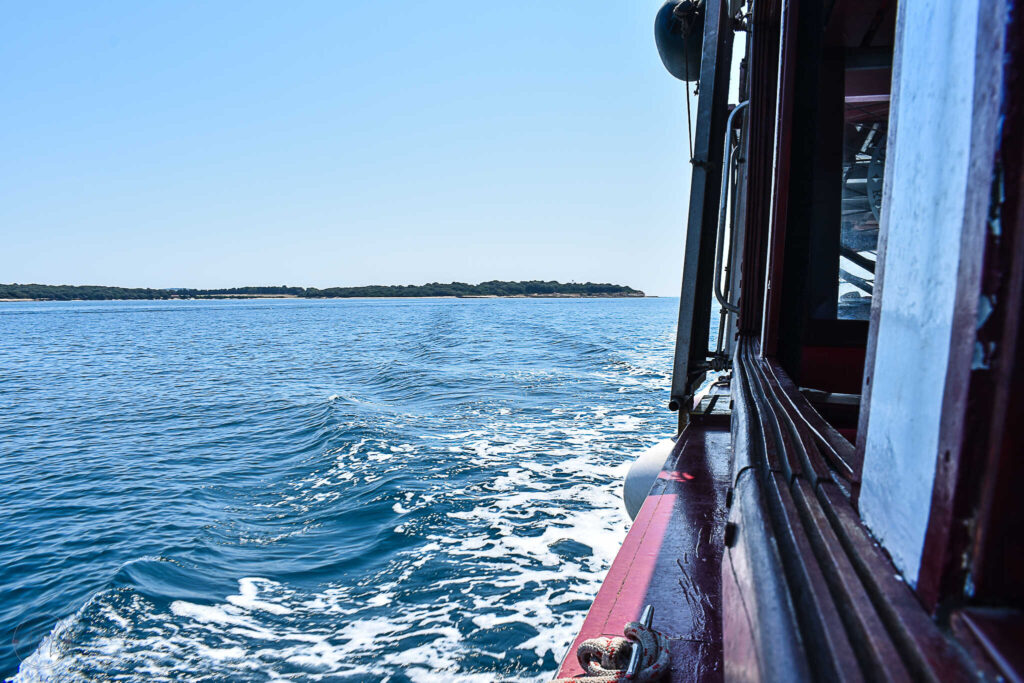
I don’t know about you, but going on a dolphin-watching adventure is an absolute dream come true. And where better than Croatia?
Obviously, there’s no guarantee you’ll see dolphins on your evening out, but the experience is more than worthwhile.
This three-hour boat tour leaves Pula in the evening, where a guide will explain dolphin behavior, local marine life, and show you what to look for out in the water.
Dinner and unlimited drinks are also included on this romantic evening out.
Enjoy the open Adriatic Sea with a great dinner, a beautiful sunset, and hopefully some dolphin sightings! You can make your reservation for this dolphin-watching experience online.
26. Take a guided tour to Istrian cities near Pula

As much as I love Pula, there are some incredible cities in the region too!
If you don’t have enough time to explore some of the other towns on your own, check out this Istria in 1 Day Tour for some great things to do near Pula.
They’ll pick you up in Pula in front of the Amphitheater and facilitate your transportation to several of the most beautiful towns in the Istria region–like Rovinj, Poreč, Grožnjan, and Motovun.
27. Visit Cape Kanenjak on the Premantura peninsula
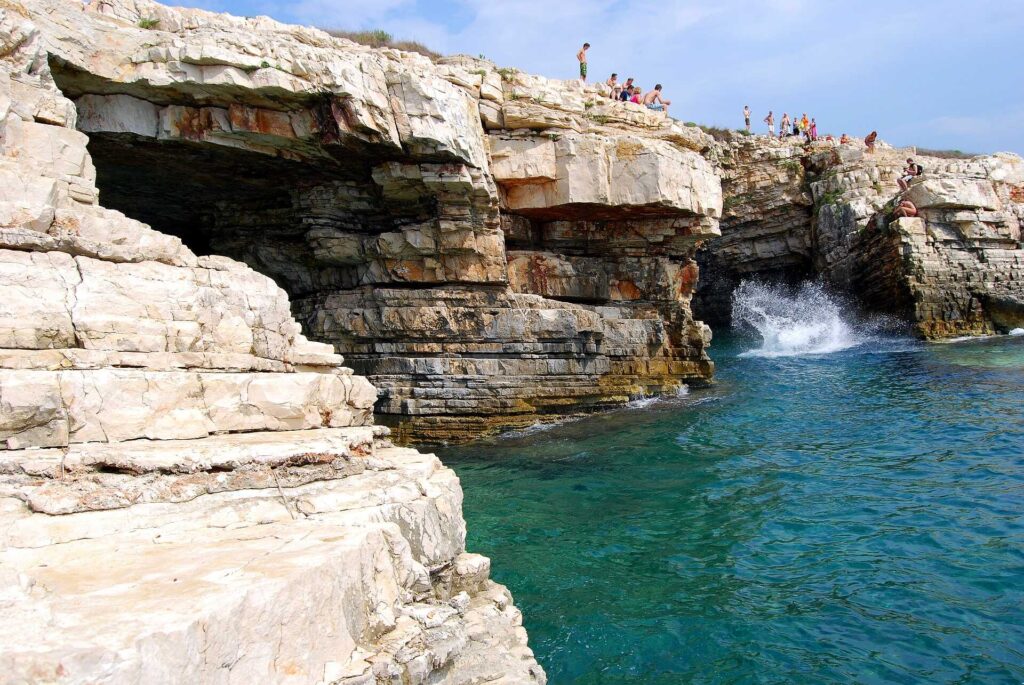
Cape Kamenjak is another beautiful place to visit near Pula. The area is a nature reserve that protrudes off the southern tip of the peninsula of Premantura.
There are eleven uninhabited islands off the coast, about twenty different species of orchids along with other indigenous plants, and dinosaur footprints along the peninsula.
Take a Caves and Canyons speedboat tour instead of renting a car and driving there (which you’ll have to pay a fee since the peninsula is vehicle-free).
You’ll leave right from Pula’s harbor and head over to see the cliffs and caves before stopping to swim.
28. Explore outside the city center on a Pula Highlights Bike Adventure
Ready to go on a Croatia road trip?
If you’re looking for a way to get out and explore the hidden gems of Pula, then this Pula Highlights Bike Adventure is just what you need.
On this guided 3-hour bike tour, your guide will show you all the best that the area has to offer.
You’ll start off by biking past the Arena, along the old town and seafront promenade, then over to Pigeon’s Cave to cool off with some swimming, snorkeling, and optional cliff jumping.
After, continue along the coastline with magnificent coves, beaches, views, and sea caves before cycling through Verudela Canyon, where you can experience more breathtaking views with a stunning sunset and go cliff jumping again if you want.
29. Go on a Pula kayaking adventure
Enjoy some of Pula’s most popular beaches from a new perspective–the water!
On this kayaking adventure, you can explore spots that you’d probably never find alone.
Follow your knowledgeable guide as they take you around Seagull’s Rocks and its cliffs, grottos, and coves.
At each stop, you’ll learn more about Pula’s geology and history.
You’ll even get to snorkel in multiple caves and take part in some thrilling cliff-jumping.
And don’t worry if you didn’t bring any gear with you; all the necessary equipment you’ll need to stay safe and have fun on this adventure is included with your booking.
30. Take a day trip to another Istrian, or Italian, city
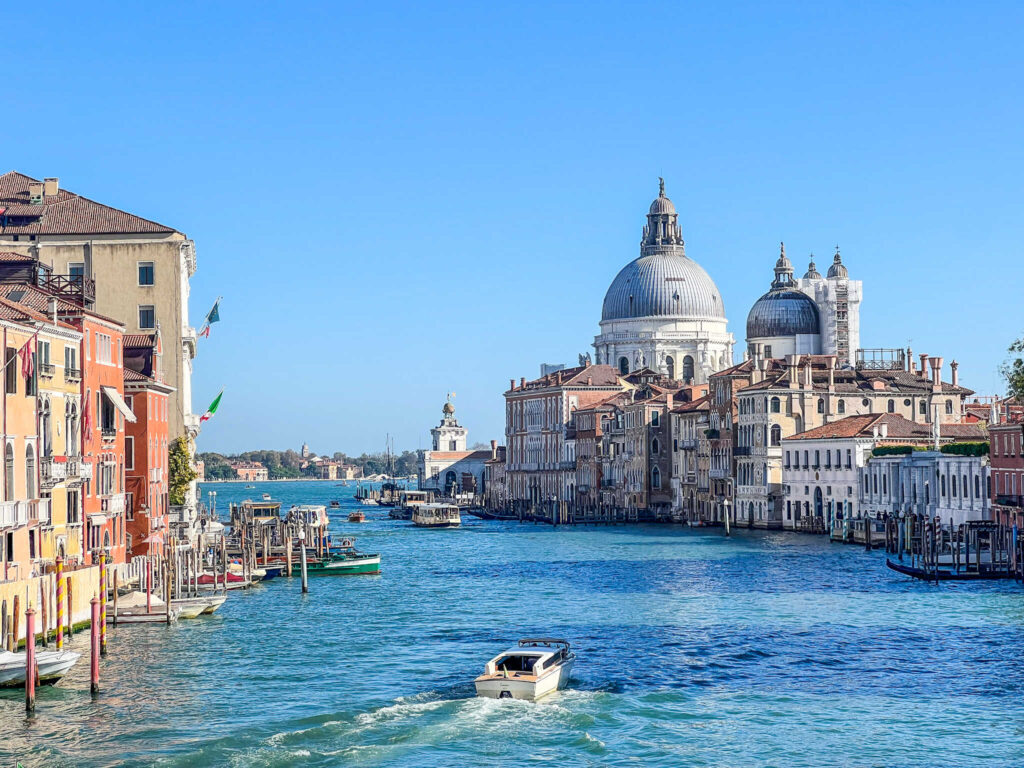
If you have other Croatian cities on your bucket list, it’s so easy to visit other towns from Pula using public transport options like the ferry.
If you take a look at CroatiaFerries.com, you can see the ferry schedule for the nine different ports you can travel to from Pula.
Other beautiful Croatian cities like Rovinj and Zadar, and even Italian cities like Trieste and–my favorite–the Medieval town of Venice.
Did you even imagine that taking a day trip from Pula to Venice is possible?!
What to do in Pula Croatia: FAQs
What are the best things to do in Pula, Croatia?
1. Visit the Pula Arena
2. Walk around the Pula Old Town
3. Explore Forum Square and see the Temple of Augustus
4. Take a walking tour of Pula
5. Walk around Tito’s Park by the harbor
6. Visit the Pula Cathedral
7. See the Arch of the Sergii
8. Sit by the James Joyce Statue
9. Walk around the Church and Monastery of St. Francis
10. Climb to the top of the Kaštel
11. Walk through the Gate of Hercules
12. See the remaining chapel of the Basilica of Santa Maria del Canneto
13. Check out the Kažnjavanje Dirke Mosaic
14. Visit the Pula Aquarium
15. Take a boat tour through Brijuni Islands National Park
16. Relax on one of Pula’s beaches
17. Stroll through the Twin Gates to reach the Archaeological Museum of Istria
18. Learn to taste at the Museum of Olive Oil
19. Visit one of Pula’s other incredible museums
20. Go underground at Zerostrasse
21. Visit the remains of Agrippina’s House
22. Grab a bite at the Gradska Tržnica
23. See The Lighting Giants
24. Attend the Vinski Grad this summer
25. Watch for dolphins in the water while enjoying the sunset
26. Take a guided tour to Istrian cities near Pula
27. Visit Cape Kanenjak on the Premantura peninsula
28. Explore outside the city center on a Pula Highlights Bike Adventure
29. Go on a Pula kayaking adventure
30. Take a day trip to another Istrian, or Italian, city
What country is Pula in?
Pula is a city located in the country of Croatia. It’s situated on the Istrian Peninsula in the northern part of the country.
Pula Croatia Things to do: Wrap-Up
No matter what your preferences are, you’re sure to find tons of fun activities in Pula.
Whether you want to marvel at its Roman ruins, explore the lively markets and cafes, or take part in water sports on the Adriatic side—there are plenty of things to keep you busy on your visit.
And let’s not forget about the natural beauty of this incredible city. From the crystal-clear waters of the Adriatic Sea to the lush green forests that surround the city, Pula is a place that will leave you in awe of the world around you.
What historical sites and activities will make your list of the best things to do in Pula, Croatia?

